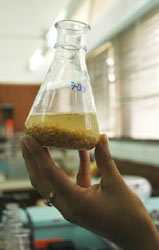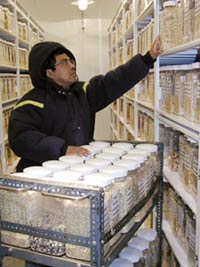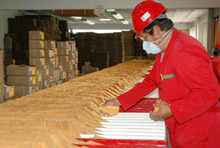Bug Havens Keep Maize Pest-Proof
CIMMYT E-News, vol 2 no. 12, December 2005
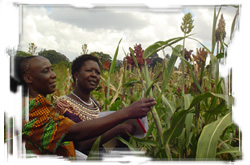 African maize farmers who will grow transgenic maize varieties resistant to one of the crop’s most damaging pests—the maize stem borer—learn that to keep borers at bay, some must survive.
African maize farmers who will grow transgenic maize varieties resistant to one of the crop’s most damaging pests—the maize stem borer—learn that to keep borers at bay, some must survive.
Maize stem borers destroy approximately 12% of Kenya’s maize crop annually—losses valued at more than US$ 50 million. Under the Insect Resistant Maize for Africa (IRMA) project, the Kenya Agricultural Research Institute (KARI), CIMMYT, and the Syngenta Foundation for Sustainable Agriculture have worked in partnership since 1999 to offer farmers maize varieties that resist borers. They are drawing this resistance from several sources, including maize landraces and experimental varieties and even a common soil bacterium, Bacillus thuringiensis (Bt). The latter produces its own, natural insecticide: a protein that perforates borer larvae’s stomach lining, causing them to starve. There are several types of this protein and each is very selective, affecting certain species of borers but no other animals. Researchers have taken the gene responsible for the protein and put it into maize, thereby obtaining a plant that borers of the targeted species cannot safely eat.
The resistance from Bt is effective until, through a chance mutation, an individual borer emerges that can beat it. Borer offspring with the same mutation will eventually become more numerous than other borers, making the Bt-based resistance useless.
A safe haven for borers
Farmers in developed countries who grow Bt maize usually protect its effectiveness through use of “refugia”—fodders or cereal crops that foster the survival and reproduction of Bt-susceptible borers. IRMA recently sponsored a two-day workshop on refugia at KARI’s Kitale center. The 50 participants—19 researchers, and 17 extension staff, and 14 farmers from 9 districts of North Rift Valley and 2 neighboring districts—learned about the progress in the development of insect resistant maize and the importance of refugia.
“It’s not hard to find refugia for stem borers; the challenge is to find refugia that both work and are acceptable to farmers,” says KARI entomologist Dr. Margaret Mulaa, who organized the Kitale workshop, and leads the insect resistance management (IRM) component of the IRMA project. “The refugia species have to fit in with the farmers’ cropping systems.”
All workshop participants took to the field to evaluate and score potential crops and varieties that could be used as stem-borer refugia on farms. They ranked the top 5 each from among 15 sorghum and 18 grass varieties, and 4 maize varieties for their attractiveness as food, fodder, or refugia for stem borers.
Farmers lead the way scoring refugia
The farmers raced ahead of the other two groups, doing what comes most naturally to them: visually assessing the yield and disease resistance of the sorghum varieties; squeezing the sorghum grains between two fingers and tasting them to judge texture and flavor; splitting open maize and grass stalks to assess moisture content and borer damage; and examining fodder crops for yield, vigor, and traits like hairiness and moisture content—important indicators of palatability for livestock. “Bana grass yields well and is not too hairy, so my cows enjoy it,” said Philomen Berut, a farmer from South Nandi who has received two awards for the best livestock at the Kitale Agricultural show.
More than 26 different criteria were given for selecting the sorghum varieties, but the major ones were high yield, early maturity, tolerance to pests and diseases, short height (which helps plants resist lodging), and tolerance to bird damage.
And the winners?
All three groups ranked the ‘local brown’ and ‘local red’ sorghum varieties among the top five favorites. Four improved Napier varieties (Kakamega 1 & 2, Napier 16798 and 16837) were also ranked top by all three groups. The popular maize hybrid H614 was ranked among the best five refugia species for its stable yield, lush foliage, and good cobs.
Mulaa finds this type of information extremely important for developing an IRM strategy that farmers will actually use. “By understanding farmers’ choices and criteria early enough, the resistance management package that IRMA will introduce along with Bt maize will have the farmer’s hand in its design, making it more likely to succeed.”
For more information contact Stephen Mugo (s.mugo@cgiar.org)
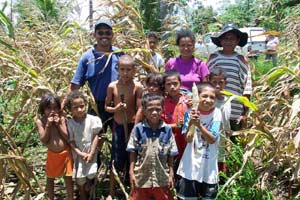 After almost 450 years of foreign occupation, East Timor became the world’s newest country when it declared independence in May 2002. Facing a host of hurdles as it rebuilds destroyed towns and damaged infrastructure, one thing the country lacks is productive and well-adapted germplasm for major crops.
After almost 450 years of foreign occupation, East Timor became the world’s newest country when it declared independence in May 2002. Facing a host of hurdles as it rebuilds destroyed towns and damaged infrastructure, one thing the country lacks is productive and well-adapted germplasm for major crops. Almost 800,000 people live in East Timor, which was once a Portuguese colony. The BBC estimates that about 25% of the population died during Indonesia’s occupation, which began after Portugal withdrew in 1975 and lasted until 1999. After citizens voted for independence, anti-independence militia killed hundreds of people and destroyed towns and already poor infrastructure.
Almost 800,000 people live in East Timor, which was once a Portuguese colony. The BBC estimates that about 25% of the population died during Indonesia’s occupation, which began after Portugal withdrew in 1975 and lasted until 1999. After citizens voted for independence, anti-independence militia killed hundreds of people and destroyed towns and already poor infrastructure.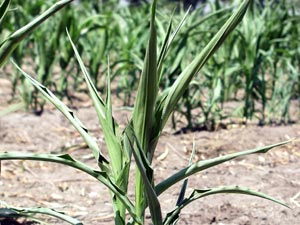 This growing season in south-central Kenya has been a good test for the new drought tolerant maize varieties being bred in Africa. This is a semi-arid area, but this year they can drop the semi. Farmers report only three short periods of rain since the February planting time.
This growing season in south-central Kenya has been a good test for the new drought tolerant maize varieties being bred in Africa. This is a semi-arid area, but this year they can drop the semi. Farmers report only three short periods of rain since the February planting time.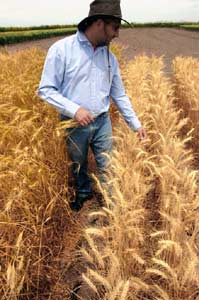 Centuries ago, Spanish monks brought wheat to Mexico to use in Roman Catholic religious ceremonies. The genetic heritage of some of these “sacramental wheats” lives on in farmers’ fields. CIMMYT researchers have led the way in collecting and characterizing these first wheats, preserving their biodiversity and using them as sources of traits like disease resistance and drought tolerance.
Centuries ago, Spanish monks brought wheat to Mexico to use in Roman Catholic religious ceremonies. The genetic heritage of some of these “sacramental wheats” lives on in farmers’ fields. CIMMYT researchers have led the way in collecting and characterizing these first wheats, preserving their biodiversity and using them as sources of traits like disease resistance and drought tolerance.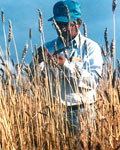
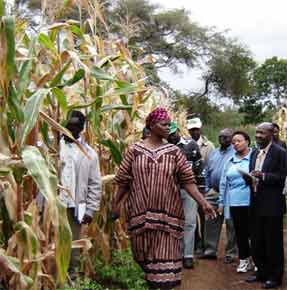 CIMMYT’s partnerships on maize in eastern Africa hark back to the 1960s, when the center was launched. Formal networking since that time with researchers and extension workers, policy makers, non-government organizations, seed companies, millers, and farmers have culminated in successful breeding and dissemination teams and promising new varieties rated highly by farmers. Awards to teams in Tanzania and Ethiopia recently highlighted the value of these partnerships.
CIMMYT’s partnerships on maize in eastern Africa hark back to the 1960s, when the center was launched. Formal networking since that time with researchers and extension workers, policy makers, non-government organizations, seed companies, millers, and farmers have culminated in successful breeding and dissemination teams and promising new varieties rated highly by farmers. Awards to teams in Tanzania and Ethiopia recently highlighted the value of these partnerships.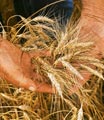 Some of the poorest and most disadvantaged wheat farmers live in areas with less than 350 mm annual rainfall and their livelihoods often depend solely on income from wheat production. Moreover, in these areas wheat is a staple food, providing around half the daily caloric requirement, and also constitutes an important source of fodder for livestock.
Some of the poorest and most disadvantaged wheat farmers live in areas with less than 350 mm annual rainfall and their livelihoods often depend solely on income from wheat production. Moreover, in these areas wheat is a staple food, providing around half the daily caloric requirement, and also constitutes an important source of fodder for livestock. Farmers of the village of Kathaka Kaome in Embu district near Mount Kenya are saying that quality protein maize (QPM) is as nutritious as Githeri—a local dish made from maize and beans.
Farmers of the village of Kathaka Kaome in Embu district near Mount Kenya are saying that quality protein maize (QPM) is as nutritious as Githeri—a local dish made from maize and beans.
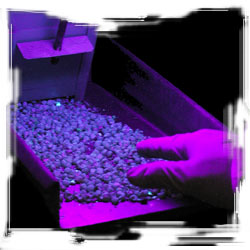 A CIMMYT research team is using an old but effective technique to get a head start on some very advanced crop science. Their aim is to breed high yielding maize that also resists infection by a dangerous fungus. As part of a USAID-funded project, the team uses ultraviolet or black light to identify maize that inhibits Aspergillus flavus, a fungus that produces potent toxins known as aflatoxins.
A CIMMYT research team is using an old but effective technique to get a head start on some very advanced crop science. Their aim is to breed high yielding maize that also resists infection by a dangerous fungus. As part of a USAID-funded project, the team uses ultraviolet or black light to identify maize that inhibits Aspergillus flavus, a fungus that produces potent toxins known as aflatoxins.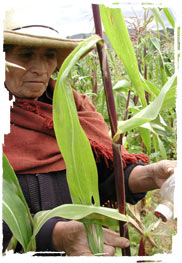 Farmers seal the corn earworm’s fate in Peru with an oily approach.
Farmers seal the corn earworm’s fate in Peru with an oily approach.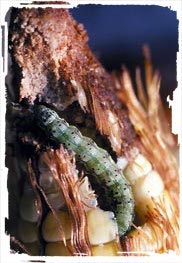
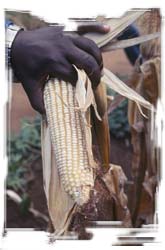 New, elite maize lines from CIMMYT offer enhanced nutrition and disease resistance.
New, elite maize lines from CIMMYT offer enhanced nutrition and disease resistance.
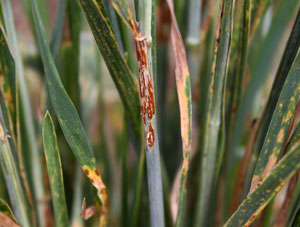 CIMMYT-led international efforts to identify and deploy sources of resistance to the virulent Ug99 strain of stem rust have received coverage on ABC1, the primary television channel of the Australian Broadcasting Corporation.
CIMMYT-led international efforts to identify and deploy sources of resistance to the virulent Ug99 strain of stem rust have received coverage on ABC1, the primary television channel of the Australian Broadcasting Corporation. Seed is the lifeblood of CIMMYT research and partnerships. Behind the scenes at CIMMYT, many thousands of seeds are on the move. Constantly arriving and departing as seed is shared with partners, they may journey through rigorous health testing in the laboratory, planting in the soils of the center’s research stations, or storage in the icy vaults of the germplasm bank.
Seed is the lifeblood of CIMMYT research and partnerships. Behind the scenes at CIMMYT, many thousands of seeds are on the move. Constantly arriving and departing as seed is shared with partners, they may journey through rigorous health testing in the laboratory, planting in the soils of the center’s research stations, or storage in the icy vaults of the germplasm bank.